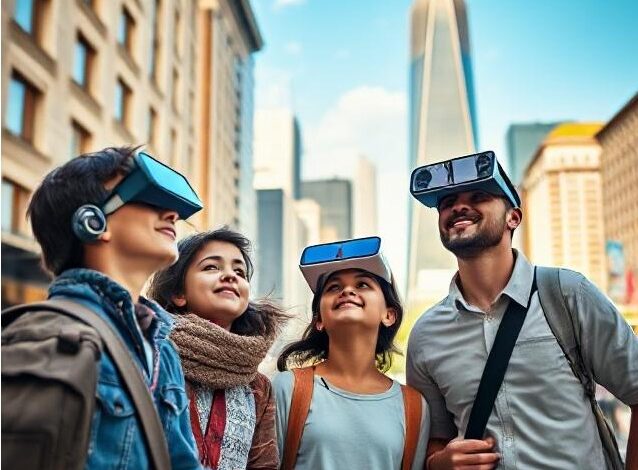
Imagine sipping coffee at a Parisian café, watching the Eiffel Tower light up as the sun sets—without ever stepping outside your room. Or trekking through the Himalayas, feeling the rush of wind and the crunch of snow underfoot, all from the comfort of a Virtual Reality (VR) headset. Welcome to the world of Virtual Travel Stations (VTS)—a transformative concept at the crossroads of immersive technology, global tourism, and digital accessibility.
As the lines blur between physical and virtual reality, the tourism industry is entering a new era—one not bound by geography, financial means, or physical ability. Virtual Travel Stations could redefine the way we explore our world, making once-distant dreams accessible, affordable, and sustainable.
What is a Virtual Travel Station?
A Virtual Travel Station is an advanced digital platform powered by VR (Virtual Reality) and AR (Augmented Reality) technologies. It allows users to immerse themselves in photorealistic recreations of famous tourist destinations—from walking through the streets of Venice to stargazing in the Atacama Desert. These stations could be installed in homes, libraries, community centers, airports, malls, or even public kiosks.
Using 360° imaging, real-time rendering, spatial audio, and haptic feedback, the experience feels remarkably close to actually being there. It’s not just visual—it’s emotional, sensory, and interactive.
The Technology Behind the Vision
The foundation of VTS lies in existing and rapidly improving technologies:
- VR Headsets (like Meta Quest or Apple Vision Pro) offer immersive visuals and motion tracking.
- AR Glasses provide real-world overlays to enhance physical exploration.
- Photogrammetry and 3D mapping recreate historical and natural environments in stunning detail.
- AI tour guides and voice assistants simulate human interaction, storytelling, and personalization.
- Haptic gear (gloves, suits, etc.) simulate physical sensations like touch, wind, or temperature changes.
Together, these tools offer a compelling illusion of presence, transporting users across space and time.
Opportunities and Benefits
1. Tourism for All
VTS democratizes travel. Many people—due to age, disability, financial constraints, or geopolitical issues—are unable to explore global destinations. With a Virtual Travel Station, anyone with access to a VR setup can visit iconic locations, cultural sites, or natural wonders.
Imagine a school child in a remote village visiting the Louvre or a senior citizen in a care home exploring Kyoto’s cherry blossoms. Travel becomes a right, not a privilege.
2. Sustainable Exploration
Tourism, while economically important, often harms the environment—through air travel emissions, over-tourism, and ecosystem disruption. VTS offers a carbon-neutral alternative. It could especially protect fragile sites like coral reefs, ancient ruins, or endangered forests by reducing human footprint.
Virtual experiences can also raise awareness about climate change and conservation by showcasing environmental challenges firsthand.
3. Cultural Preservation and Education
VTS can act as digital museums, preserving disappearing cultures, languages, festivals, and monuments. Users could experience traditional dance performances in Rajasthan, tribal rituals in Africa, or ancient Mayan ruins—with accurate storytelling guided by historians or AI avatars.
For students, this becomes a dynamic educational tool: history, geography, and social studies taught not through textbooks, but through firsthand experience.
4. Commercial and Tourism Industry Integration
Travel agencies, airlines, and hospitality chains can offer previews of destinations, accommodations, and itineraries, helping customers plan with confidence. Local businesses can promote regional experiences virtually, attracting travelers who are more likely to book trips after a taste of what’s offered.
It’s also a boon for places recovering from natural disasters or political unrest—tourism can continue virtually, helping sustain the local economy.
Future Possibilities
Looking ahead, Virtual Travel Stations will evolve into fully social and interactive ecosystems. Imagine:
- Group travel where users from different parts of the world meet in a virtual Rome and explore together.
- Gamified experiences with treasure hunts, history quests, or local food challenges.
- Time-travel features, letting users experience ancient Rome or ancient India with full sensory immersion.
- Integration with the metaverse, where travel is part of a broader digital lifestyle—attending festivals, shopping, or even earning rewards.
We might even see Virtual Travel Subscriptions—like Netflix for travel—offering monthly adventures around the world from the comfort of your living room.
Challenges Ahead
Of course, some hurdles remain:
- High setup cost of VR gear, though it’s decreasing.
- Digital access gap, especially in rural or underdeveloped areas.
- Need for authentic, respectful representation of cultures and traditions.
- Data privacy and safety in shared VR spaces.
But with the right investment, partnerships, and policy frameworks, these challenges are solvable.
Conclusion: A New Era of Exploration
Virtual Travel Stations will not replace real-world travel. Nothing can match the feeling of standing on a mountain peak or dipping your toes in a foreign ocean. But they can complement, expand, and reimagine the way we explore.
In a world that’s becoming more conscious of sustainability, inclusivity, and innovation, VTS offers a powerful tool to bridge divides—geographical, economic, and cultural. As the technology continues to evolve, the dream of seeing the world may no longer depend on a passport—but on a headset and an open mind.
📌 Stay tuned with The Horizon Times as we continue to spotlight how innovation is rewriting the future of work and life.





